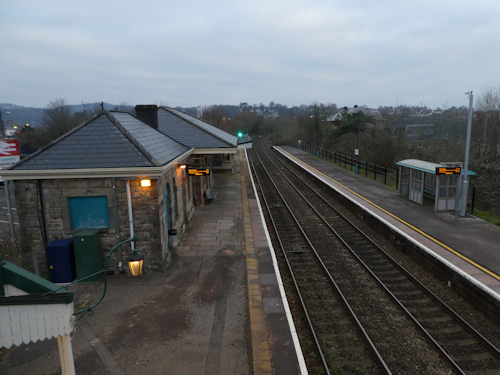
|
The 1959 service started its voyage of discovery at 11:20 (what's the opposite of discovery for a voyage making a known journey for the last time?) from Chepstow station. Having to walk meant setting out before 9am, when the station was just emerging from pre-dawn twilight. It has changed somewhat since 1959, with the loss of the down platform building, the platform extensions, all loops and sidings (the only pointwork remaining is for the use of WVR stone trains) and some rather handsome trees. The main building's slate roof is our first major change since 2009, being a 2013 replacement of the metal panels which had served for most of the intervening years. The second major change is that the Severn Estuary line has been resignalled, so Chepstow station now has Up and Down Starter signals again (basic but effective black panels with LEDs scattered across them). The viewpoint used in 2009 of the river crossing from the east bank of the river is no longer repeatable, owing to tree growth. |
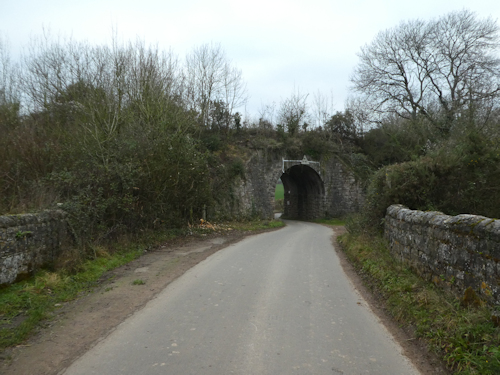
|
The first underbridge on the WVR, over Snipe Hill Lane, from the bridge which carries the lane over the adjacent mainline. In 1917 this bit of road made a rather nice study opportunity for ways to get roads across railways, with a level crossing a few yards more to the south-west carrying it across the branchline to Sedbury and Beachley. Now the crossing has gone (though its location can still be made out) and the WVR is derelict; the steps which climb to track level at this point have also vanished into the gorse bushes and young trees. A new sign on who to contact in the event of bridge bashes has been attached to the bridge in recent years to reflect a move of operations control for the route from Swindon to Cardiff. |
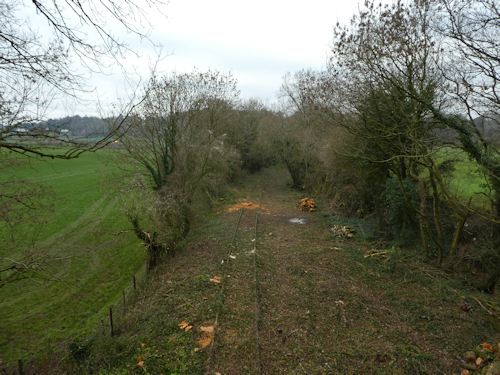
|
The National Diving & Activity Centre have rather taken Tidenham station in hand in recent years, incorporating it into a "Fear Walk" and reflecting its new value by fencing it off with more enthusiasm than has previously been the case (accompanied by threats of CCTV recording for good measure). The line northwards from Bishton Bridge to Netherhope was not part of this enthusiasm for some time, but in the last few weeks has finally been cleared of major vegetation. Unfortunately the chain gang, rather than taking the felled timber away to heat their houses, have instead laid it out in the "four foot" and burned it, causing minor damage to the fossilised sleepers. The gently curving formation, untouched by wheels since 1981 and unphotographable throughout the life of this website, seems to plead for a train to pass over it in this view off Bishton Bridge. |
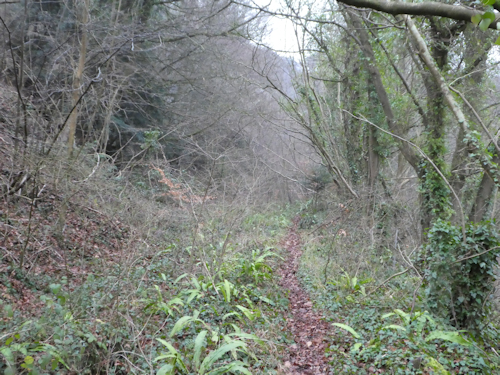
|
Tintern Quarry's loops are yet to receive the attention of the chain gang, so are seen here, from the recently-refurbished Footpath 19, still lost amongst the ferns and saplings that have grown up since the previous clearance work about 15 years ago. The footpath, notorious for having been blown up to make way for Tintern Quarry, has recently been the subject of a formal demand by the Council that the landowner bring it back up to scratch. This has been done with some vegetation clearance, fencing to separate walkers from the quarry face, yellow arrow markers at strategic locations (mostly to clarify that the public right of way does not follow the railway at this point) and very handsome timber staircases down some of the steeper bits of hillside. There are still some barbed wire fences to tidy and a tatty "Danger - Quarry Ahead" sign to repair. The Railway Paths organisation has followed up this work by getting the line past the quarry made into a permissive path for recreational purposes and putting up little signs to this effect (although it is still a dead end - the tunnel has been made rather more secure since 2009, with the pallisade fence having been replaced in early 2016 by a solid fence coated in non-drying paint that has been topped with steel shark's teeth since the previous topping of razor wire was found to be inadequate). We will overlook the fact that the new footpath actually misses the holes in the railway fence which mark the right of way. |
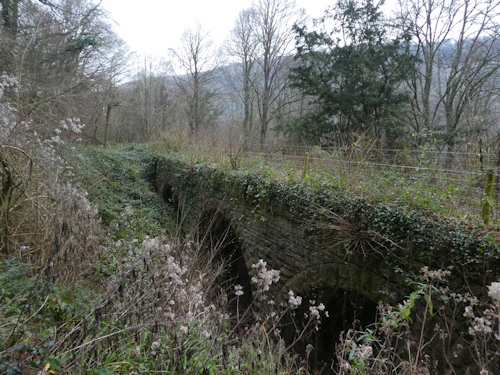
|
Someone got round a couple of years ago to removing the worst of the vegetation from the easily-missed Black Morgan Viaduct - all three arches of it - in 2016. Some of it has grown back, but the structure looks rather better than it did in 2009. It carried the line over a small impression in the hillside below Shorn Cliff. |
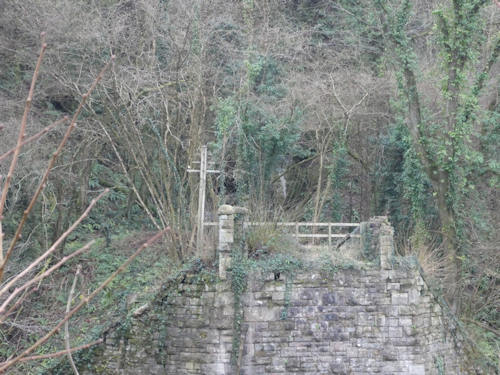
|
For many years the south abutment of the river crossing at Tintern, marking the end of the continuous trackbed from Wye Valley Junction, was lost in a chaos of trees. These were removed a couple of years back, revealing the fence along the abutment top (which had been missing for some time, but an increase in the number of people dropping down the hill to pay tribute to Tintern Tunnel's north portal made its repair a worthwhile exercise before some idiot, taking the concept of following every inch of the trackbed slightly too far, managed to fall off) and a telegraph pole that the demolition contractor had forgotten to push into the river. A particular feature of the work is that enough vegetation has been cleared to mean that in January it is just possible to pick out the tunnel portal. In 2009 the South portal was secured by a set of steel gates with handsome spikes while the North portal was secured by a rusty door with its bolt on the inside. At some point in 2009 the gates were left unlocked, followed by a careless visitor forgetting to bolt the door after completing an inspection. Later the gates fell over altogether. This seemed at the time to be in anticipation of their removal, but things have tightened up again and they have been replaced by a new pallisade fence. The door in the North portal has been replaced for good measure. |
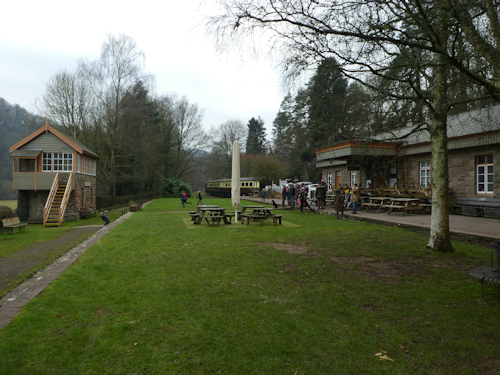
|
The Old Station at Tintern was rather warmer on Saturday 5th January 2019 than it was on Sunday 4th January 2009. This may have been one reason why the station had rather more visitors than it did ten years ago, though it still doesn't open for the anniversary of its closure. Otherwise the major change is the replacement of the coaching stock sat on the length of track near to the site of the former cattle dock; the old Mark 1 van is in the Great Carriage Shed in the Sky, the GWR carriage is stored on the West Somerset Railway and the "Bloater" van has received a coat of paint. Someone with nothing more constructive to do seems to have been trying to break into it recently. Out of view are the also ex-railway weighbridge and stationmaster's house. |
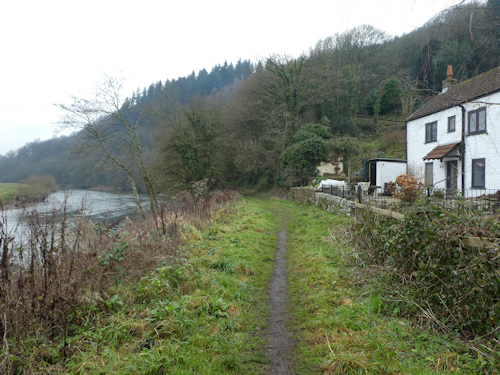
|
The WVR trackbed between Llandogo and Brockweir, being not open to the public, not obvious from the road and not terribly interesting from the other bank of the river, has not been extensively photographed. So here is a picture of the trackbed as it enters the Llandogo area, squeezed between river and cottage. It nicely highlights how intact the trackbed is - and how adjacent some of the neighbours are. |

|
St Briavels has seen once of the more notable changes of the last ten years - the goods shed has fallen in and subsequently been partially demolished. This was not a great surprise (pity as it was) given that it had spent some years buried under a mass of ivy that it wasn't really worth the owner's time to remove. (Presuming, of course, that the cost of tidying up the ruin didn't exceed the cost of removing the ivy a decade earlier.) The platform fence was installed by BR in the mid-1950s and seems to be doing well. |
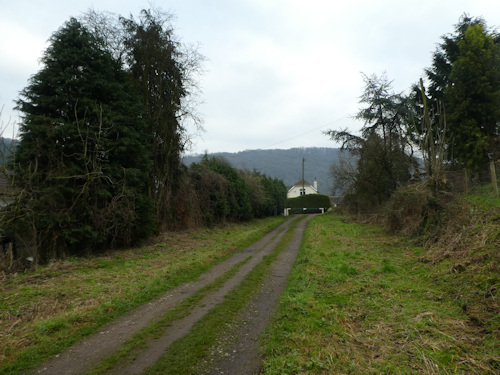
|
Whitebrook, by contrast, makes quite a "spot the difference" competition since 2009. The hedge in front of the cottage has grown slightly, the crossing cottage owners seem to have replaced their car and the gate has been repainted with white highlights. The picture shows the remains of the halt platform (what remains?) rather than focusing on the cottage and crossing. |
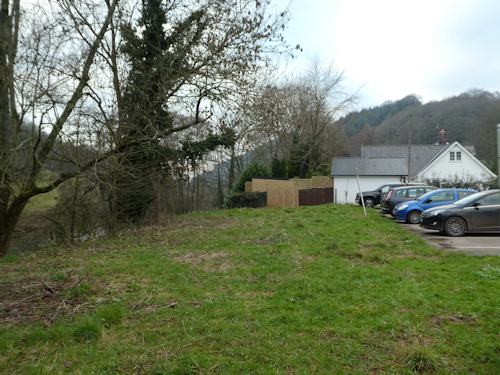
|
Redbrook has seen quite a few changes since 2009. Out of view, on the other side of the house shown here, the cottage by the old station platform has done some tree clearance and replaced their fencing. This house, built on the footprint of the old goods shed, has added another garden shed and replaced some of their fence panels. The car park was surfaced with tarmac and made "pay and display" in 2010, making it look rather like a station car park - shame the station is still nowhere to be seen. An old stone hut by the former yard entrance, looking rather like a weighbridge but shown on railway plans as being sold off as long ago as 1911, still stands sentinel amongst its coating of ivy and the remains of its roof. The other change becoming apparent at this point is an improvement at timing walks - it being dusk by the time the 2009 walk got here, but still being daylight in 2019. |
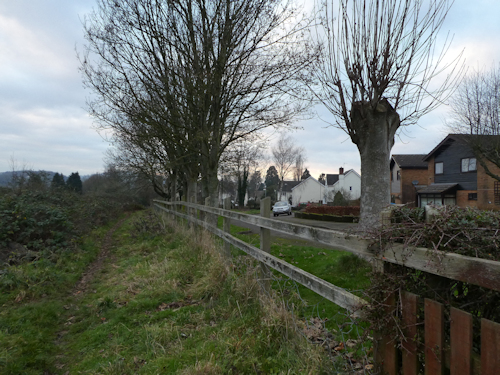
|
One would not expect much in the way of change at Wyesham Halt in the intervening years - suburban estates tend to have a fairly stable air - and sure enough the place looks almost exactly the same. The site of the junction, quarter of a mile to the east, is somewhat more overgrown than it was in 2009; the divergence of trackbeds, clearly visible in the early years of the century, has vanished beneath a mass of brambles. |
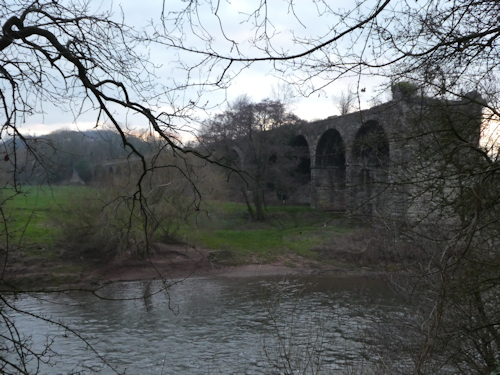
|
A bonus of the lack of change is that the campaign for the demolition of the Monmouth Viaduct has gained no momentum, so the structure remains standing. It is as handsome as ever, though some effort removing trees from the trackbed would not go amiss. The contrast with the adjacent Ross & Monmouth river crossing remains a point of general interest, particularly as both were built by Newport-based civil engineer Joseph Firbank. |
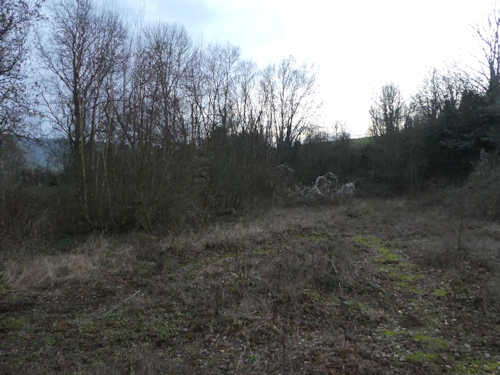
|
It is naturally a matter of some delight that Monmouth Troy station still has not been redeveloped, even with the cyclepath from Monmouth May Hill that is curiously marked on current 1:25,000 Ordnance Survey maps. Not that in the gloom of dusk on the 5th of January 2019 the fact that the station still awaits its next train was quite sufficient to take away a feeling of something - possibly just regret - on scrambling through its bramble-strewn remains to find the tunnel portal at the end of the long walk from Chepstow. The Welsh Government consultation on the new Transport for Wales franchise got some helpful suggestions from someone that the station facilities at Monmouth station - presumably Troy - should be improved; we await the reappearance of a waiting room for passengers looking for signs of a train service to somewhere. Having missed the previous train from Troy by an even greater margin than in 2009, it was resolved to take up the offer of the convenient chauffeur-driven Bedmobile again instead of limping hurriedly to Monmouth's nearest railhead (Lydney, at 10 miles as the crow flies, as opposed to 11 miles to Chepstow or 12 to Abergavenny). The particular bonus of the Bedmobile was an opportunity to get in some further mileage on the former Coleford, Monmouth, Usk & Pontypool Railway, which continues to do duty in a revised state as required by current Government transport policy. |
Well, it turns out that the line has not been re-opened, which it is fortunately possible to blame on Brexit rather than, say, a lack of get-up-and-go, a failure to properly challenge the pervading attitude that it was a sensible closure and there is no business case for restoration or the shortage of a budget. We will all just have to look forward to the 70th anniversary instead. It seems unlikely that the line will be in the same sort of condition in 2029, but then again it seemed unlikely in 2009 that it would still be in the same condition in 2019. It is not actually a positive comment on the state of the national economy during the intervening decade that a line which has seen at least four different visions for its development during that time (a cycleway, a 15inch-gauge line at Tintern, a 2ft-gauge line between Tidenham and Tintern and full restoration) has really only altered in so far as some of the trees have grown or been chopped down. The consequence is a line which looks like a train could be run very happily between Tidenham and Tintern Quarry, although unfortunately this became apparent too late for a whip-round to procure one. Christmas 2018 did however offer the truly desperate the opportunity to "get in" the only bit of Monmouth's rail network still used, even occasionally, by planned standard-gauge passenger trains - the trailing crossover at the east end of Chepstow station provided for Wye Valley stone trains to gain the Down line after Wye Valley Junction box was abolished. (Severn Tunnel Junction was blocked for electrification works, so Cross Country trains from Nottingham turned back in platform 1 at Chepstow before using the crossover to gain the Up line. The WVR continues to have a small transport legacy.)
Since 2009 loco No. 6412, the survivor of the pair that hauled the closure special, has been sold by the West Somerset Railway back to the South Devon Railway, who have carried out a major overhaul and (reasonably, for the loco which hauled their re-opening special and Guest Star Dr. Richard Beeching) seem to view it as a bit of a fleet pet. It was away from the SDR over the New Year, but at Shackerstone visiting a fellow "64xx" rather than on the Dean Forest or Gloucestershire & Warwickshire lines.
<<<Return to Wye Valley Railway<<<